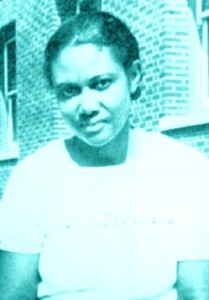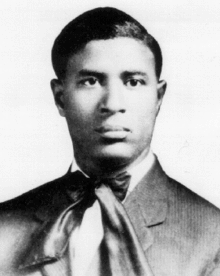Black History, Science
 Dr. Frances J. Bonner, (1919-2000) was born in Saint Louis, and grew up in Greensboro, North Carolina, where her father David D. Jones was president of Bennett College, an institution devoted to the education of young Afro-American women.
Dr. Frances J. Bonner, (1919-2000) was born in Saint Louis, and grew up in Greensboro, North Carolina, where her father David D. Jones was president of Bennett College, an institution devoted to the education of young Afro-American women.
While a freshman at Bennett College, she led a successful protest and boycott of the local movie theaters in Greensboro North Carolina. (The theaters in North and South Carolina would not show movies where Whites and Afro-Americans were depicted as equals.) After months of picketing their efforts were successful, leading the Carolina Times to conclude that “the step taken by the students in the two Negro schools in Greensboro shows more courage on the part of Negro youth than we have any record of anywhere else in the south.” (more…)
Black History, Science

Philip Emeagwali
Dr Philip Chukwurah Emeagwal, mathematician and computer scientist, was born on August 23, 1954 in Akure, a remote village in Nigera son of James and Agatha Emeagwali; He was the oldest of nine children and his father, who worked as a nurse’s aide, earned only a modest income.
As a result, at age 14, Philip was forced to drop out of school in Onitsha because his father could not continue paying the fees to keep him in school. He had shown such great promise in mathematics that his classmates nicknamed him “Calculus.â€�, his father encouraged him to continue learning at home. (more…)
Black History, Science

Roger Arliner Young
Roger Arliner Young was the first African-American woman to receive a doctorate in zoology, after years of juggling research and teaching with the burden of caring for her invalid mother. Her story is one of grit and perseverance.
Roger Arliner Young grew up in Burgettstown, Pennsylvania. In 1916, she entered Howard University. In 1921, she took her first science course, under Ernest Everett Just, a prominent black biologist and head of the zoology department at Howard. Although her grades were poor, Just saw some promise and started mentoring Young. She graduated with a bachelor’s degree in 1923.
Her relationship with Just improved her skills, and he continued working with her. According to his biographer, Just probably chose a woman protégé because he thought men more likely to pursue lucrative careers in medicine than to remain in academe. Just helped Young find funding to attend graduate school.
In 1924 she entered the University of Chicago part-time. Her grades improved dramatically. She was asked to join Sigma Xi, an unusual honor for a master’s student. She also began publishing her research. Her first article, “On the Excretory Apparatus in Paramecium,” appeared in Science in September 1924. She obtained her master’s degree in 1926. (more…)

Black History, Inventions, Science

Lloyd August Hall
Born: June 20, 1894
Died: January 2, 1971
Birthplace: Elgin, Illinois
Occupation: Chemist and Inventor
Lloyd August Hall received his Bachelor of Science from Northwestern University in 1914, a Master of Science from Northwestern in 1916, and a Doctor of Science (D.Sc.) from Virginia State College in 1944. Dr. Hall has served as junior and senior Sanitary Chemist of the Department of Health laboratories for the city of Chicago, Illinois from 1915 to 1919. He also served as chief chemist for John Morrel and Company of Ottuma, Illinois (1919-1921). He was President of the Chemical Products Corporation, Chicago from 1921 to 1924. Dr. Hall served as Consultant for Griffith’s Laboratories from 1925 to 1929, later as Technical Director and Chief Chemist of Griffith’s Laboratories in Chicago, Illinois from 1929 to 1946. From 1946 to 1959 Lloyd hall served as Technical Director. (more…)
Black History, Science
 Clarence “Skip” Ellis was born in 1943 and grew up in a very poor neighborhood of the south side of Chicago. His mother struggled to raise five children by herself. Gangs and violence were common in school. Skip wasn’t one of the “cool” kids – he mostly kept to himself. At the time, he was sad because he felt excluded from so many things. Surprisingly, this helped him because he was able to avoid the gangs, violence and problems some kids in his class got into.
Clarence “Skip” Ellis was born in 1943 and grew up in a very poor neighborhood of the south side of Chicago. His mother struggled to raise five children by herself. Gangs and violence were common in school. Skip wasn’t one of the “cool” kids – he mostly kept to himself. At the time, he was sad because he felt excluded from so many things. Surprisingly, this helped him because he was able to avoid the gangs, violence and problems some kids in his class got into.
At 15, Skip took a job at a local company to help support his family. He was assigned the “graveyard shift,” which meant he had to work all night long. His job was to prevent break-ins and, most importantly, not to touch the company’s brand new computer! It was 1958 and computers were very expensive and not very common. Since he had lots of free time, he read the computer manuals that came with the machines. He became a self-taught computer expert. One day, there was a crisis at the company… (more…)
Black History, Inventions, Science

Garrett Morgan
Garrett A. Morgan (1875-1963), inventor; born in Paris, Tenn.
Morgan developed his first invention, a belt fastener for sewing machines, in 1901, and he sold it for $150. In 1914 he won the First Grand Prize gold medal at the Second International Exposition of Sanitation and Safety for his breathing helmet and smoke protector (prototype to the gas mask).
In 1916 he demonstrated the use of this device in the rescue operation following an explosion in a tunnel at the Cleveland Waqterworks that trapped many men below Lake Erie. In 1923, Morgan developed an automatic stop sign to aid the movement of traffic, selling the rights to this invention to General Electric for $40,000.
At the Emancipation Centennial Celebration in Chicago, Illinois, in August 1963, Morgan was nationally recognized. Although in ill-health, and nearly blind, he continued to work on his inventions; one of his last was a self-extinguishing cigarette, which employed a small plastic pellet filled with water, placed just before the filter.
 Dr. Frances J. Bonner, (1919-2000) was born in Saint Louis, and grew up in Greensboro, North Carolina, where her father David D. Jones was president of Bennett College, an institution devoted to the education of young Afro-American women.
Dr. Frances J. Bonner, (1919-2000) was born in Saint Louis, and grew up in Greensboro, North Carolina, where her father David D. Jones was president of Bennett College, an institution devoted to the education of young Afro-American women.



 Clarence “Skip” Ellis was born in 1943 and grew up in a very poor neighborhood of the south side of Chicago. His mother struggled to raise five children by herself. Gangs and violence were common in school. Skip wasn’t one of the “cool” kids – he mostly kept to himself. At the time, he was sad because he felt excluded from so many things. Surprisingly, this helped him because he was able to avoid the gangs, violence and problems some kids in his class got into.
Clarence “Skip” Ellis was born in 1943 and grew up in a very poor neighborhood of the south side of Chicago. His mother struggled to raise five children by herself. Gangs and violence were common in school. Skip wasn’t one of the “cool” kids – he mostly kept to himself. At the time, he was sad because he felt excluded from so many things. Surprisingly, this helped him because he was able to avoid the gangs, violence and problems some kids in his class got into.